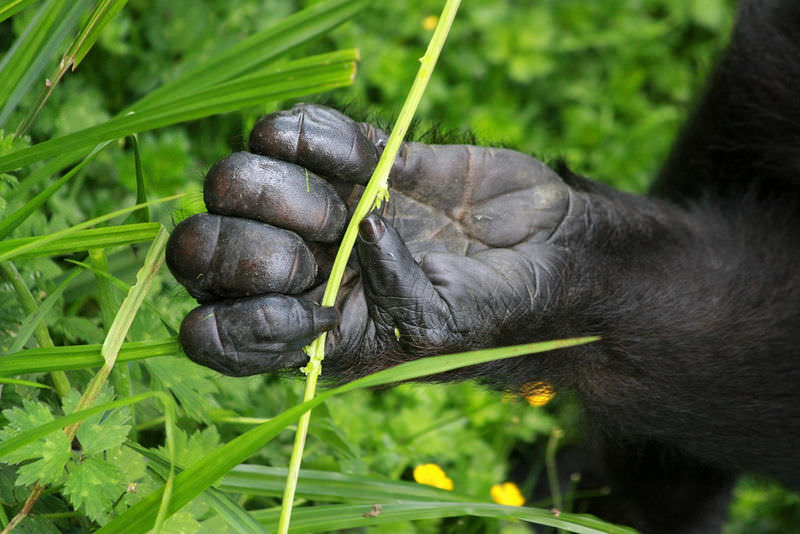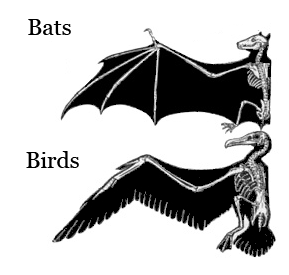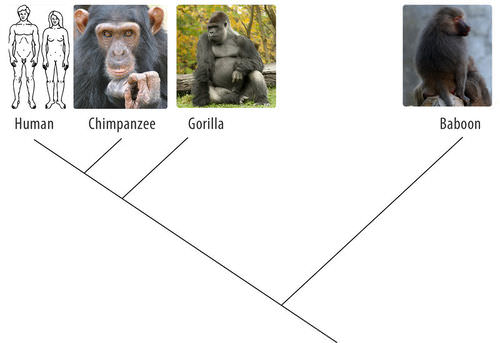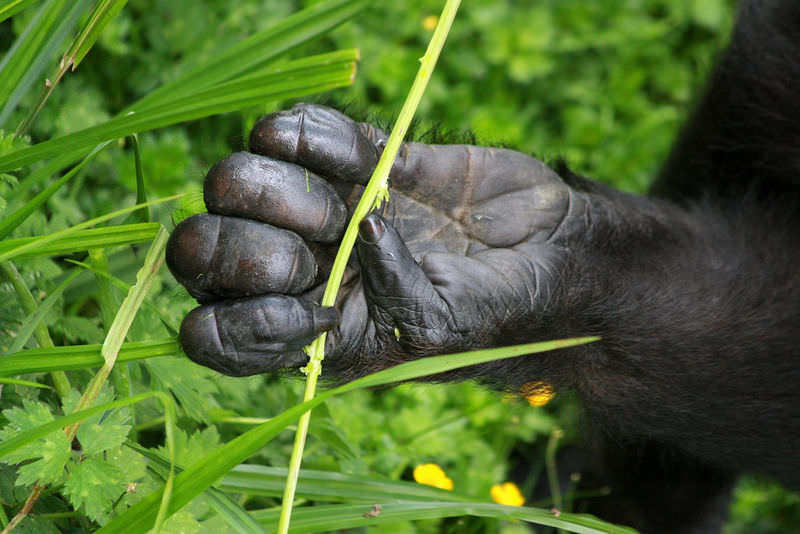5.7: Comparative Anatomy
- Page ID
- 12109
\( \newcommand{\vecs}[1]{\overset { \scriptstyle \rightharpoonup} {\mathbf{#1}} } \)
\( \newcommand{\vecd}[1]{\overset{-\!-\!\rightharpoonup}{\vphantom{a}\smash {#1}}} \)
\( \newcommand{\dsum}{\displaystyle\sum\limits} \)
\( \newcommand{\dint}{\displaystyle\int\limits} \)
\( \newcommand{\dlim}{\displaystyle\lim\limits} \)
\( \newcommand{\id}{\mathrm{id}}\) \( \newcommand{\Span}{\mathrm{span}}\)
( \newcommand{\kernel}{\mathrm{null}\,}\) \( \newcommand{\range}{\mathrm{range}\,}\)
\( \newcommand{\RealPart}{\mathrm{Re}}\) \( \newcommand{\ImaginaryPart}{\mathrm{Im}}\)
\( \newcommand{\Argument}{\mathrm{Arg}}\) \( \newcommand{\norm}[1]{\| #1 \|}\)
\( \newcommand{\inner}[2]{\langle #1, #2 \rangle}\)
\( \newcommand{\Span}{\mathrm{span}}\)
\( \newcommand{\id}{\mathrm{id}}\)
\( \newcommand{\Span}{\mathrm{span}}\)
\( \newcommand{\kernel}{\mathrm{null}\,}\)
\( \newcommand{\range}{\mathrm{range}\,}\)
\( \newcommand{\RealPart}{\mathrm{Re}}\)
\( \newcommand{\ImaginaryPart}{\mathrm{Im}}\)
\( \newcommand{\Argument}{\mathrm{Arg}}\)
\( \newcommand{\norm}[1]{\| #1 \|}\)
\( \newcommand{\inner}[2]{\langle #1, #2 \rangle}\)
\( \newcommand{\Span}{\mathrm{span}}\) \( \newcommand{\AA}{\unicode[.8,0]{x212B}}\)
\( \newcommand{\vectorA}[1]{\vec{#1}} % arrow\)
\( \newcommand{\vectorAt}[1]{\vec{\text{#1}}} % arrow\)
\( \newcommand{\vectorB}[1]{\overset { \scriptstyle \rightharpoonup} {\mathbf{#1}} } \)
\( \newcommand{\vectorC}[1]{\textbf{#1}} \)
\( \newcommand{\vectorD}[1]{\overrightarrow{#1}} \)
\( \newcommand{\vectorDt}[1]{\overrightarrow{\text{#1}}} \)
\( \newcommand{\vectE}[1]{\overset{-\!-\!\rightharpoonup}{\vphantom{a}\smash{\mathbf {#1}}}} \)
\( \newcommand{\vecs}[1]{\overset { \scriptstyle \rightharpoonup} {\mathbf{#1}} } \)
\( \newcommand{\vecd}[1]{\overset{-\!-\!\rightharpoonup}{\vphantom{a}\smash {#1}}} \)
\(\newcommand{\avec}{\mathbf a}\) \(\newcommand{\bvec}{\mathbf b}\) \(\newcommand{\cvec}{\mathbf c}\) \(\newcommand{\dvec}{\mathbf d}\) \(\newcommand{\dtil}{\widetilde{\mathbf d}}\) \(\newcommand{\evec}{\mathbf e}\) \(\newcommand{\fvec}{\mathbf f}\) \(\newcommand{\nvec}{\mathbf n}\) \(\newcommand{\pvec}{\mathbf p}\) \(\newcommand{\qvec}{\mathbf q}\) \(\newcommand{\svec}{\mathbf s}\) \(\newcommand{\tvec}{\mathbf t}\) \(\newcommand{\uvec}{\mathbf u}\) \(\newcommand{\vvec}{\mathbf v}\) \(\newcommand{\wvec}{\mathbf w}\) \(\newcommand{\xvec}{\mathbf x}\) \(\newcommand{\yvec}{\mathbf y}\) \(\newcommand{\zvec}{\mathbf z}\) \(\newcommand{\rvec}{\mathbf r}\) \(\newcommand{\mvec}{\mathbf m}\) \(\newcommand{\zerovec}{\mathbf 0}\) \(\newcommand{\onevec}{\mathbf 1}\) \(\newcommand{\real}{\mathbb R}\) \(\newcommand{\twovec}[2]{\left[\begin{array}{r}#1 \\ #2 \end{array}\right]}\) \(\newcommand{\ctwovec}[2]{\left[\begin{array}{c}#1 \\ #2 \end{array}\right]}\) \(\newcommand{\threevec}[3]{\left[\begin{array}{r}#1 \\ #2 \\ #3 \end{array}\right]}\) \(\newcommand{\cthreevec}[3]{\left[\begin{array}{c}#1 \\ #2 \\ #3 \end{array}\right]}\) \(\newcommand{\fourvec}[4]{\left[\begin{array}{r}#1 \\ #2 \\ #3 \\ #4 \end{array}\right]}\) \(\newcommand{\cfourvec}[4]{\left[\begin{array}{c}#1 \\ #2 \\ #3 \\ #4 \end{array}\right]}\) \(\newcommand{\fivevec}[5]{\left[\begin{array}{r}#1 \\ #2 \\ #3 \\ #4 \\ #5 \\ \end{array}\right]}\) \(\newcommand{\cfivevec}[5]{\left[\begin{array}{c}#1 \\ #2 \\ #3 \\ #4 \\ #5 \\ \end{array}\right]}\) \(\newcommand{\mattwo}[4]{\left[\begin{array}{rr}#1 \amp #2 \\ #3 \amp #4 \\ \end{array}\right]}\) \(\newcommand{\laspan}[1]{\text{Span}\{#1\}}\) \(\newcommand{\bcal}{\cal B}\) \(\newcommand{\ccal}{\cal C}\) \(\newcommand{\scal}{\cal S}\) \(\newcommand{\wcal}{\cal W}\) \(\newcommand{\ecal}{\cal E}\) \(\newcommand{\coords}[2]{\left\{#1\right\}_{#2}}\) \(\newcommand{\gray}[1]{\color{gray}{#1}}\) \(\newcommand{\lgray}[1]{\color{lightgray}{#1}}\) \(\newcommand{\rank}{\operatorname{rank}}\) \(\newcommand{\row}{\text{Row}}\) \(\newcommand{\col}{\text{Col}}\) \(\renewcommand{\row}{\text{Row}}\) \(\newcommand{\nul}{\text{Nul}}\) \(\newcommand{\var}{\text{Var}}\) \(\newcommand{\corr}{\text{corr}}\) \(\newcommand{\len}[1]{\left|#1\right|}\) \(\newcommand{\bbar}{\overline{\bvec}}\) \(\newcommand{\bhat}{\widehat{\bvec}}\) \(\newcommand{\bperp}{\bvec^\perp}\) \(\newcommand{\xhat}{\widehat{\xvec}}\) \(\newcommand{\vhat}{\widehat{\vvec}}\) \(\newcommand{\uhat}{\widehat{\uvec}}\) \(\newcommand{\what}{\widehat{\wvec}}\) \(\newcommand{\Sighat}{\widehat{\Sigma}}\) \(\newcommand{\lt}{<}\) \(\newcommand{\gt}{>}\) \(\newcommand{\amp}{&}\) \(\definecolor{fillinmathshade}{gray}{0.9}\)
Is this evidence of evolution?
Take a close look at this gorilla hand. The similarities to a human hand are remarkable. Comparing anatomy, and characterizing the similarities and differences, provides evidence of evolution.
Evidence from Living Species
Just as Darwin did many years ago, today’s scientists study living species to learn about evolution. They compare the anatomy, embryos, and DNA of modern organisms to understand how they evolved.
Comparative Anatomy
Comparative anatomy is the study of the similarities and differences in the structures of different species. Similar body parts may be homologies or analogies. Both provide evidence for evolution.
Homologous structures are structures that are similar in related organisms because they were inherited from a common ancestor. These structures may or may not have the same function in the descendants. Figure below shows the hands of several different mammals. They all have the same basic pattern of bones. They inherited this pattern from a common ancestor. However, their forelimbs now have different functions.
 The forelimbs of all mammals have the same basic bone structure.
The forelimbs of all mammals have the same basic bone structure.Analogous structures are structures that are similar in unrelated organisms. The structures are similar because they evolved to do the same job, not because they were inherited from a common ancestor. For example, the wings of bats and birds, shown in Figure below, look similar on the outside. They also have the same function. However, wings evolved independently in the two groups of animals. This is apparent when you compare the pattern of bones inside the wings.
 Wings of bats and birds serve the same function. Look closely at the bones inside the wings. The differences show they developed from different ancestors.
Wings of bats and birds serve the same function. Look closely at the bones inside the wings. The differences show they developed from different ancestors.Comparative Embryology
Comparative embryology is the study of the similarities and differences in the embryos of different species. Similarities in embryos are evidence of common ancestry. All vertebrate embryos, for example, have gill slits and tails. Most vertebrates, except for fish, lose their gill slits by adulthood. Some of them also lose their tail. In humans, the tail is reduced to the tail bone. Thus, similarities organisms share as embryos may be gone by adulthood. This is why it is valuable to compare organisms in the embryonic stage.
Vestigial Structures
Structures like the human tail bone and whale pelvis are called vestigial structures. Evolution has reduced their size because the structures are no longer used. The human appendix is another example of a vestigial structure. It is a tiny remnant of a once-larger organ. In a distant ancestor, it was needed to digest food. It serves no purpose in humans today. Why do you think structures that are no longer used shrink in size? Why might a full-sized, unused structure reduce an organism’s fitness?
Comparing DNA
Darwin could compare only the anatomy and embryos of living things. Today, scientists can compare their DNA. Similar DNA sequences are the strongest evidence for evolution from a common ancestor. More similarities in the DNA sequence is evidence for a closer evolutionary relationship. Look at the cladogram in the Figure below. It shows how humans and apes are related based on their DNA sequences.
 Cladogram of Humans and Apes. This cladogram is based on DNA comparisons. It shows how humans are related to apes by descent from common ancestors.
Cladogram of Humans and Apes. This cladogram is based on DNA comparisons. It shows how humans are related to apes by descent from common ancestors.Summary
- Scientists compare the anatomy, embryos, and DNA of living things to understand how they evolved.
- Evidence for evolution is provided by homologous structures. These are structures shared by related organisms that were inherited from a common ancestor.
- Other evidence for evolution is provided by analogous structures. These are structures that unrelated organisms share because they evolved to do the same job.
- Comparing DNA sequences provided some of the strongest evidence of evolutionary relationships.
Review
- What are vestigial structures? Give an example.
- Compare homologous and analogous structures.
- Why do vertebrate embryos show similarities between organisms that do not appear in the adults?
- Humans and apes have five fingers they can use to grasp objects. Do you think these are analogous or homologous structures? Explain.
- What is the strongest evidence of evolution from a common ancestor?
| Image | Reference | Attributions |
 |
[Figure 1] | Credit: Human: User:MrKimm/Wikimedia Commons; Chimpanzee: Afrika Force; Gorilla: Roger Luijten; Baboon: Birdseye Maple;John Romanes, modified by CK-12 Foundation;Albert kok Source: Human: commons.wikimedia.org/wiki/File:Human-gender-neutral.png ; Chimpanzee: http://www.flickr.com/photos/afrikaforce/5187391191 ; Gorilla: http://www.flickr.com/photos/66555186@N02/6312198231 ; Baboon: http://www.flickr.com/photos/26198976@N04/4007297452 ; commons.wikimedia.org/wiki/File:Homology.jpg ; commons.wikimedia.org/wiki/File:Caribbean_reef_shark.jpg License: Human: Public Domain; Chimpanzee, Gorilla, Baboon: CC BY 2.0 |
 |
[Figure 2] | Credit: Christopher Auyeung Source: CK-12 Foundation License: CC BY-NC 3.0 |
 |
[Figure 3] | Credit: John Romanes, modified by CK-12 Foundation Source: commons.wikimedia.org/wiki/File:Homology.jpg License: Public Domain |
 |
[Figure 4] | Credit: Human: User:MrKimm/Wikimedia Commons; Chimpanzee: Afrika Force; Gorilla: Roger Luijten; Baboon: Birdseye Maple Source: Human: commons.wikimedia.org/wiki/File:Human-gender-neutral.png ; Chimpanzee: http://www.flickr.com/photos/afrikaforce/5187391191 ; Gorilla: http://www.flickr.com/photos/66555186@N02/6312198231 ; Baboon: http://www.flickr.com/photos/26198976@N04/4007297452 License: Human: Public Domain; Chimpanzee, Gorilla, Baboon: CC BY 2.0 |

